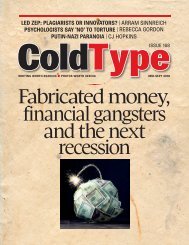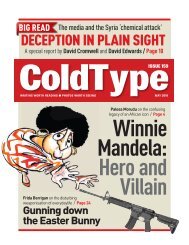ColdType Issue 29 Extra 1 -2008
www.coldtype.net
www.coldtype.net
Create successful ePaper yourself
Turn your PDF publications into a flip-book with our unique Google optimized e-Paper software.
WRITING WORTH READING ● ISSUE <strong>29</strong> ● AUGUST <strong>2008</strong><br />
TheREADER<br />
<strong>ColdType</strong><br />
E X TRA⁄ 1<br />
SYNTHETIC<br />
POT AS<br />
A MILITARY<br />
WEAPON?<br />
Meet Dr James<br />
Ketchum, the<br />
man who ran<br />
America’s<br />
secret program<br />
MARTIN A. LEE
Martin A. Lee is the author of Acid Dreams: The Complete<br />
Social History of LSD: The CIA, the Sixties, and Beyond.<br />
He is writing a social history of marijuana. A version of this article<br />
originally appeared in Cannabis Culture.<br />
© Martin A. Lee <strong>2008</strong><br />
<strong>ColdType</strong><br />
WRITING WORTH READING FROM AROUND THE WORLD<br />
http://coldtype.net<br />
2 TheREADER | EXTRA | August <strong>2008</strong>
SYNTHETIC POT AS A<br />
MILITARY WEAPON?<br />
Meet the man who ran America’s secret program<br />
BY MARTIN A. LEE<br />
Dr. James Ketchum tested<br />
a potent form of synthetic<br />
marijuana on soldiers to develop<br />
a secret weapon in the ‘60s.<br />
Now he’s telling the tale<br />
It was billed as a panel discussion<br />
on “the global shift in human consciousness.”<br />
A half-dozen speakers<br />
had assembled inside the Heebie<br />
Jeebie Healers tent at Burning<br />
Man, the annual post-hippie celebration<br />
in Black Rock, Nev., where 50,000<br />
stalwarts braved intense dust storms and<br />
flash floods last August. Among the notables<br />
who spoke at the early evening forum<br />
was Dr. Alexander “Sasha” Shulgin, the<br />
Bay Area-based psychochemical genius<br />
much beloved among the Burners, who<br />
synthesized Ecstasy and 200 other psychoactive<br />
drugs and tested each one on<br />
himself during his unique, offbeat career.<br />
Sitting on the panel next to Shulgin was<br />
an unlikely expositor. Dr. James S.<br />
Ketchum, a retired U.S. Army colonel, told<br />
the audience, “When Sasha was trying to<br />
open minds with chemicals to achieve<br />
Top military<br />
officers hyped<br />
the notion of<br />
“war without<br />
death,”<br />
conjuring visions<br />
of aircraft<br />
swooping over<br />
enemy territory<br />
releasing clouds<br />
of “madness<br />
gas” that would<br />
disorient the bad<br />
guys and<br />
dissolve their<br />
will to resist,<br />
while U.S.<br />
soldiers moved<br />
in and took over<br />
greater awareness, I was busy trying to<br />
subdue people.”<br />
Ketchum was referring to his work at<br />
Edgewood Arsenal, headquarters of the<br />
U.S. Army Chemical Corps, in the 1960s,<br />
when America’s national security strategists<br />
were high on the prospect of developing<br />
a nonlethal incapacitating agent, a socalled<br />
humane weapon, that could knock<br />
people out without necessarily killing anyone.<br />
Top military officers hyped the notion<br />
of “war without death,” conjuring visions<br />
of aircraft swooping over enemy territory<br />
releasing clouds of “madness gas” that<br />
would disorient the bad guys and dissolve<br />
their will to resist, while U.S. soldiers<br />
moved in and took over.<br />
Ketchum was into weapons of mass<br />
elation, not weapons of mass destruction.<br />
He oversaw a secret research program that<br />
tested an array of mind-bending drugs on<br />
American GIs, including an exceptionally<br />
potent form of synthetic marijuana. (Most<br />
of these drugs had no medical names, just<br />
numbers supplied by the Army.) “Paradoxical<br />
as it may seem,” Ketchum asserted,<br />
“one can use chemical weapons to<br />
spare lives, rather than extinguish them.”<br />
August <strong>2008</strong> | EXTRA | TheREADER 3
MARTIN A. LEE<br />
Some of the Burners were perplexed.<br />
Was this guy cool or creepy?<br />
Shulgin, a critic of chemical mind-meddling<br />
by the military, was wary when he<br />
first met Ketchum at a 1993 event honoring<br />
the 50th anniversary of the discovery of<br />
LSD. But Ketchum is not your typical military<br />
bulldozer type. An intelligent, gracious<br />
man with a disarming sense of humor,<br />
in his own way he has always been a<br />
free spirit. He and his wife, Judy, who currently<br />
reside in Santa Rosa, became close<br />
friends with Sasha and his formidable<br />
partner, Ann. They stayed in frequent contact<br />
and occasionally socialized together.<br />
When the Shulgins invited them to Burning<br />
Man, the Ketchums joined the caravan<br />
of RVs driving to the desert.<br />
“I’m kind of a Sasha worshipper,”<br />
Ketchum, who reads neuropharmacology<br />
textbooks during his leisure hours, confessed.<br />
Tall and lanky, the colonel, now 76,<br />
is one of the few people who can actually<br />
understand what Shulgin, six years his<br />
senior, is talking about when he lectures<br />
on the molecular subtleties of psychedelic<br />
drugs, waving his arms furiously like a<br />
mad scientist. Shulgin took Ketchum under<br />
his wing and welcomed him into the<br />
fold.<br />
Shulgin wrote the foreword to<br />
Ketchum’s self-published memoir, Chemical<br />
Warfare: Secrets Almost Forgotten, which<br />
lifts the veil on the Army’s little-known<br />
drug experiments and illuminates a hidden<br />
chapter of marijuana history. A graduate<br />
of Cornell Medical College, Ketchum<br />
describes how he was assigned as a staff<br />
psychiatrist to Edgewood Arsenal, located<br />
25 miles northeast of Baltimore, in 1961.<br />
“There was no doubt in my mind that<br />
working in this strange atmosphere was<br />
just the sort of thing that would satisfy my<br />
“The dog gets a<br />
peculiar<br />
reaction. He<br />
crawls under the<br />
table, stays<br />
away from the<br />
dark, leaps out<br />
at imaginary<br />
objects and, as<br />
far as one can<br />
interpret, may<br />
be having<br />
hallucinations,”<br />
one report<br />
stated.<br />
“It would appear<br />
even to the<br />
untrained<br />
observer that<br />
this dog is not<br />
normal. He<br />
suddenly jumps<br />
out, even<br />
without any<br />
stimulus, and<br />
barks, and then<br />
crawls back<br />
under the table”<br />
appetite for novelty,” Ketchum wrote.<br />
Soon he became chief of clinical research at<br />
the Army’s hub for chemical warfare studies.<br />
Although the Geneva Convention had<br />
banned the use of chemical weapons,<br />
Washington never agreed to this provision,<br />
and the U.S. government poured<br />
money into the search for a nonlethal incapacitant.<br />
Red Oil<br />
The U.S. Army Chemical Corp’s marijuana<br />
research began several years before<br />
Ketchum joined the team at Edgewood. In<br />
1952, the Shell Development Corporation<br />
was contracted by the Army to examine<br />
“synthetic cannabis derivatives” for their<br />
incapacitating properties. Additional studies<br />
into possible military uses of marijuana<br />
began two years later at the University of<br />
Michigan medical school, where a group of<br />
scientists led by Dr. Edward F. Domino,<br />
professor of pharmacology, tested a drug<br />
called “EA 1476” — otherwise known as<br />
“Red Oil” — on dogs and monkeys at the<br />
behest of the U.S. Army. Made through a<br />
process of chemical extraction and distillation,<br />
Red Oil, akin to hash oil, packed a<br />
mightier punch than the natural plant.<br />
Army scientists found that this concentrated<br />
cannabis derivative produced effects<br />
unlike anything they had previously<br />
seen. “The dog gets a peculiar reaction.<br />
He crawls under the table, stays away<br />
from the dark, leaps out at imaginary objects<br />
and, as far as one can interpret, may<br />
be having hallucinations,” one report<br />
stated. “It would appear even to the untrained<br />
observer that this dog is not normal.<br />
He suddenly jumps out, even without<br />
any stimulus, and barks, and then crawls<br />
4 TheREADER | EXTRA | August <strong>2008</strong>
SYNTHETIC POT AS A MILITARY WEAPON<br />
back under the table.”<br />
With a larger dose of Red Oil, the reaction<br />
was even more pronounced. “These<br />
animals lie on their side; you could step on<br />
their feet without any response; it is an<br />
amazing effect and a reversible phenomenon.<br />
It has greatly increased our interest in<br />
this compound from the standpoint of future<br />
chemical possibilities.”<br />
In the late 1950s, the Army started testing<br />
Red Oil on U.S. soldiers at Edgewood.<br />
Some GIs smirked for hours while they<br />
were under the influence of EA 1476. When<br />
asked to perform routine numbers and<br />
spatial reasoning tests, the stoned volunteers<br />
couldn’t stop laughing.<br />
But Red Oil was not an ideal chemicalwarfare<br />
candidate. For starters, it was a<br />
“crude” preparation that contained many<br />
components of cannabis besides psychoactive<br />
THC. Army scientists surmised that<br />
pure THC would weigh much less than<br />
Red Oil and would therefore be better<br />
suited as a chemical weapon. They were<br />
intrigued by the possibility of amplifying<br />
the active ingredient of marijuana, tweaking<br />
the mother molecule, as it were, to enhance<br />
its psychogenic effects. So the<br />
Chemical Corps set its sights on developing<br />
a synthetic variant of THC that could<br />
clobber people without killing them.<br />
Enter Harry Pars, a scientist working<br />
with Arthur D. Little Inc., based in Cambridge,<br />
Mass., one of several pharmaceutical<br />
companies that conducted chemical<br />
warfare research for the Army. (Two Army<br />
contracts for marijuana-related research<br />
were awarded to this firm, covering a 10-<br />
year period beginning in 1963.) A frequent<br />
visitor to Edgewood, Pars synthesized a<br />
new cannabinoid compound, dubbed “EA<br />
2233,” which was significantly stronger<br />
than Red Oil.<br />
They were<br />
intrigued by the<br />
possibility of<br />
amplifying the<br />
active ingredient<br />
of marijuana,<br />
tweaking the<br />
mother<br />
molecule,<br />
as it were, to<br />
enhance its<br />
psychogenic<br />
effects.<br />
So the Chemical<br />
Corps set its<br />
sights on<br />
developing a<br />
synthetic variant<br />
of THC that<br />
could clobber<br />
people without<br />
killing them<br />
At the outset of this project, Pars had<br />
sought the advice of Shulgin, then a brilliant<br />
young chemist employed by Dow<br />
Chemical. Shulgin was a veritable fount of<br />
information regarding how to reshape psychoactive<br />
molecules to create novel mindaltering<br />
drugs. Eager to share his arcane<br />
expertise, Shulgin gave Pars the idea to<br />
tinker with nitrogen analogs of tetrahydrocannabinol<br />
(THC). Pars never told Shulgin<br />
that he was an Army contract employee. A<br />
declassified version of Pars’ research was<br />
published in the Journal of the American<br />
Chemical Society (August 1966), in which<br />
he thanked Shulgin for “drawing our attention<br />
to the synthesis of these nitrogen<br />
analogs.”<br />
The U.S. Army Chemical Corps began<br />
clinical testing of EA 2233 on GI volunteers<br />
in 1961, the year Ketchum arrived at<br />
Edgewood Arsenal. When ingested at<br />
dosage levels ranging from 10 to 60 micrograms<br />
per kilogram of body weight, EA<br />
2233 lasted up to 30 hours, far longer than<br />
the typical marijuana buzz.<br />
“I Just Feel Like Laughing”<br />
In an interview videotaped seven hours after<br />
he had been given EA 2233, one soldier<br />
described feeling numb in his arms and<br />
unable to raise them, precluding any possibility<br />
that he could defend himself if attacked.<br />
“Everything seems comical,” he<br />
told his interlocutor.<br />
Q: How are you?<br />
A: Pretty good, I guess. ...<br />
Q: You’ve got a big grin on your face.<br />
A: Yeah. I don’t know what I’m grinning<br />
about, either.<br />
Q: Do things seem funny, or is that<br />
August <strong>2008</strong> | EXTRA | TheREADER 5
MARTIN A. LEE<br />
just something you can’t help?<br />
A: I don’t — I don’t know. I just — I<br />
just feel like laughing. ...<br />
Q: Does the time seem to pass slower<br />
or faster or any different than usual?<br />
A: No different than usual. Just —<br />
just that I mostly lose track of it. I<br />
don’t know if it’s early or late.<br />
Q: Do you find yourself doing any<br />
daydreaming?<br />
A: Yeah. I’m daydreaming all kinds of<br />
things. ...<br />
Q: Suppose you have to get up and<br />
go to work now. How would you<br />
do?<br />
A: I don’t think I’d even care.<br />
Q: Well, suppose the place were on<br />
fire?<br />
A: It would seem funny.<br />
Q: It would seem funny? Do you<br />
think you’d have the sense to get up<br />
and run out, or do you think you’d<br />
just enjoy it?<br />
A: I don’t know. Fire doesn’t seem to<br />
present any danger to me right now.<br />
... Everything just seems funny in the<br />
Army. Seems like everything somebody<br />
says, it sounds a little bit<br />
funny. ...<br />
Q: Is it like when you’re in a good<br />
mood and you can laugh at anything?<br />
A: Right. ... It’s like being out with a<br />
bunch of people and everybody’s<br />
laughing. They‘re just —<br />
Q: Having a ball?<br />
A: Yeah. And everything just seems<br />
funny.<br />
Q: Would you do this again? Take<br />
this test again?<br />
A: Yeah. Yeah. It wouldn’t bother me<br />
at all.<br />
Given the high<br />
safety margin<br />
of THC —<br />
no one has ever<br />
died from an<br />
overdose —<br />
and the<br />
likelihood that<br />
the<br />
stereoisomers<br />
would display<br />
a similar safety<br />
profile,<br />
Ketchum<br />
believes the<br />
Army may have<br />
spurned a<br />
couple of worthy<br />
prospects that<br />
were capable<br />
of filling the<br />
knock-‘em-outbut-don’t-kill-‘em<br />
niche in<br />
America’s<br />
chemical<br />
warfare arsenal<br />
EA 2233 was actually a mixture of eight<br />
stereoisomers of THC. (An isomer is a rearrangement<br />
of atoms within a given molecule;<br />
a stereoisomer entails different spatial<br />
configurations of these atoms.)<br />
Eventually, Edgewood scientists would<br />
separate the eight stereoisomers and investigate<br />
the relative potency of each of<br />
them individually in an effort to separate<br />
the wheat from the psychoactive chaff and<br />
reduce the amount of material needed to<br />
get the desired effect for chemical warfare.<br />
Only two of the stereoisomers proved<br />
to be of interest (the others didn’t have<br />
much of a knockdown effect). When administered<br />
intravenously, low doses of<br />
these two synthetic cousins of tetrahydrocannabinol<br />
triggered a dramatic drop in<br />
blood pressure to the point where test<br />
subjects could barely move. Standing up<br />
without assistance was impossible. This<br />
was construed by cautious Army doctors<br />
as a warning sign — a sudden plunge in<br />
blood pressure could be dangerous — and<br />
human experiments with single THC<br />
stereoisomers were suspended.<br />
Looking back on these studies,<br />
Ketchum wonders whether his colleagues<br />
made the right decision. “This hypotensive<br />
(blood-pressure-reducing) property, in an<br />
otherwise nonlethal compound, might be<br />
an ideal way to produce a temporary inability<br />
to fight, or do much else, without<br />
toxicological danger to life,” Ketchum says<br />
now. Given the high safety margin of THC<br />
— no one has ever died from an overdose<br />
— and the likelihood that the stereoisomers<br />
would display a similar safety profile,<br />
Ketchum believes the Army may have<br />
spurned a couple of worthy prospects that<br />
were capable of filling the knock-‘em-outbut-don’t-kill-‘em<br />
niche in America’s<br />
6 TheREADER | EXTRA | August <strong>2008</strong>
SYNTHETIC POT AS A MILITARY WEAPON<br />
chemical warfare arsenal.<br />
As for the two exemplary stereoisomers<br />
weaned from EA 2233, Ketchum speculates,<br />
“They probably would have been<br />
safe in terms of life-sparing activity. ... But<br />
a person who received them would have<br />
to lie down. If he tried to stand up and get<br />
his weapon, he would feel faint and lightheaded<br />
and he’d keel over. Essentially he<br />
would be immobilized for any military<br />
purpose until the effects wore off.”<br />
The colonel’s assessment: “A safe drug<br />
that knocks people down — what more<br />
could you ask for?”<br />
Volunteers for America<br />
With THC isomers on the back burner,<br />
the U.S. Army Chemical Corps focused on<br />
several other compounds — including<br />
LSD, PCP, methylphenidate (Ritalin) and a<br />
delirium-inducing ass-kicker known as<br />
“BZ” (a belladonna-like substance similar<br />
to atropine) — all of which were thought<br />
to have significant potential as nonlethal<br />
incapacitants.<br />
By the time the clinical testing program<br />
had run its course, 6,700 volunteers had<br />
experienced some bizarre states of consciousness<br />
at Edgewood. Under the influence<br />
of powerful mind-altering drugs,<br />
some soldiers rode imaginary horses, ate<br />
invisible chickens and took showers in full<br />
uniform while smoking phantom cigars.<br />
One garrulous GI complained that an order<br />
of toast smelled “like a French whore.”<br />
Some of their antics were so over-the-top<br />
that Ketchum had to admonish the nurses<br />
and other medical personnel not to laugh<br />
at the volunteers, even though it was unlikely<br />
that the soldiers would remember<br />
such incidents once the drugs wore off.<br />
Under the<br />
influence of<br />
powerful<br />
mind-altering<br />
drugs, some<br />
soldiers rode<br />
imaginary<br />
horses, ate<br />
invisible<br />
chickens and<br />
took showers<br />
in full uniform<br />
while smoking<br />
phantom cigars.<br />
One garrulous<br />
GI complained<br />
that an order<br />
of toast<br />
smelled “like a<br />
French whore”<br />
Ketchum insists that the staff at Edgewood<br />
went to great lengths to ensure the<br />
safety of the volunteers. (There was one<br />
untoward incident involving a civilian volunteer<br />
who flipped out on PCP and required<br />
hospitalization, but this happened<br />
before Ketchum came on board.) During<br />
the 1960s, every soldier exposed to incapacitating<br />
agents was carefully screened<br />
and prepped beforehand, according to<br />
Ketchum, and well treated throughout the<br />
experiment. They stayed in special rooms<br />
with padded walls and were monitored by<br />
medical professionals 24/7. Antidotes were<br />
available if things got out of hand.<br />
“The volunteers performed a patriotic<br />
service,” Ketchum says. “None, to my<br />
knowledge, returned home with a significant<br />
injury or illness attributable to chemical<br />
exposure,” though he admits that “a<br />
few former volunteers later claimed that<br />
the testing had caused them to suffer from<br />
some malady.” Such claims, however, are<br />
difficult to assess given that so many intervening<br />
variables may have contributed to<br />
a particular problem.<br />
A follow-up study conducted by the<br />
Army Inspector General’s office and a review<br />
panel convened by the National<br />
Academy of Sciences found little evidence<br />
of serious harm resulting from the Edgewood<br />
experiments. But a 1975 Army IG<br />
report noted that improper inducements<br />
may have been used to recruit volunteers<br />
and that getting their “informed consent”<br />
was somewhat dubious given that scientists<br />
had a limited understanding of the<br />
short- and long-term impact of some of<br />
the compounds tested on the soldiers.<br />
Ketchum draws a sharp distinction between<br />
clinical research with human subjects<br />
under controlled conditions at Edgewood<br />
Arsenal and the CIA’s reckless<br />
August <strong>2008</strong> | EXTRA | TheREADER 7
MARTIN A. LEE<br />
experiments on random, unwitting Americans<br />
who were given LSD surreptitiously<br />
by spooks and prostitutes. “Jim is very certain<br />
of his own integrity,” says Ken Goffman,<br />
aka R.U. Sirius, the former editor of<br />
the psychedelic tech magazine Mondo<br />
2000. “There is little doubt in his mind<br />
that he was doing the right thing. He felt<br />
he was working for a noble cause that<br />
would reduce civilian and military casualties.”<br />
Goffman helped Ketchum edit and<br />
polish his book manuscript, which vigorously<br />
defends the Edgewood research program.<br />
Strange bedfellows, the colonel and the<br />
counterculture scribe. Or so it would appear.<br />
But these days, Ketchum and Goffman<br />
see eye to eye on many issues. Both<br />
feel that the alleged dangers of marijuana<br />
and LSD have been way overblown. No<br />
doubt, LSD could wreak havoc on the<br />
toughest, best-trained troops, derailing<br />
their thought processes and disorganizing<br />
their behavior.<br />
When used wisely, however, LSD can be<br />
uplifting. Ketchum notes that some soldiers<br />
had insightful and rewarding experiences<br />
on acid, lending credence to reports<br />
from civilian psychiatrists that LSD was a<br />
useful therapeutic tool. “I had an interest<br />
in psychedelic drugs long before my interest<br />
in chemical warfare,” Ketchum says. “I<br />
was intrigued by the positive aspects of<br />
LSD, as well as the incapacitating aspects.”<br />
Mystery Stash<br />
One morning, Ketchum arrived at his office<br />
in Edgewood and found “a large, black<br />
steel barrel, resembling an oil drum,<br />
parked in the corner of the room,” he recounts<br />
in his book. Overcome by curiosity,<br />
Some officers<br />
at Edgewood<br />
were dipping<br />
into the Army’s<br />
stash for their<br />
own personal<br />
use.<br />
“They took LSD<br />
more often than<br />
was necessary<br />
to appreciate<br />
its clinical<br />
effects,”<br />
Ketchum<br />
admits.<br />
“They must<br />
have liked it”<br />
he opened the barrel and examined its<br />
contents. There were a dozen tightly<br />
sealed glass canisters that looked like<br />
cookie jars; the labels on the canisters indicated<br />
that each contained about three<br />
pounds of “EA 17<strong>29</strong>,” the Army’s code<br />
number for LSD. By the end of the week,<br />
the 40 pounds of government acid —<br />
enough to intoxicate several hundred million<br />
people — vanished as mysteriously as<br />
it had appeared. Ketchum still doesn’t<br />
know who put the LSD in his office or<br />
what became of it.<br />
But this much is certain: Some officers<br />
at Edgewood were dipping into the Army’s<br />
stash for their own personal use. “They<br />
took LSD more often than was necessary<br />
to appreciate its clinical effects,” Ketchum<br />
admits. “They must have liked it.”<br />
The colonel was personally a bit skittish<br />
about trying LSD. Eventually, he worked<br />
up the courage to experiment on himself.<br />
Under the watchful eye of a knowledgeable<br />
Edgewood physician, he swallowed a<br />
small dose and proceeded to take the same<br />
numerical aptitude tests that the regular<br />
volunteers were put through to measure<br />
their impairment. Constrained by the<br />
white-smock laboratory setting, his lone<br />
LSD experience was somewhat anticlimactic.<br />
“Colors were more vivid and music<br />
was more compelling,” Ketchum recalls,<br />
“but there were no breakthroughs in<br />
consciousness, no Timothy Leary stuff.<br />
Ketchum also sampled cannabis shortly<br />
after he began working for the Chemical<br />
Corps. His younger brother turned him on<br />
to marijuana, but the first time Ketchum<br />
smoked a joint nothing happened. “Later,<br />
I read about reverse tolerance. Some people<br />
don’t get high on marijuana until they<br />
use it a few times,” Ketchum explains.<br />
It wasn’t until he went on a paid, two-<br />
8 TheREADER | EXTRA | August <strong>2008</strong>
SYNTHETIC POT AS A MILITARY WEAPON<br />
When<br />
journalists<br />
briefly got wind<br />
of the Army’s<br />
ambitious<br />
psychochemical<br />
warfare<br />
program, they<br />
scoffed at the<br />
notion of making<br />
the enemy<br />
lay down their<br />
arms by turning<br />
them on<br />
year leave of absence from Edgewood that<br />
he started smoking pot socially. Ketchum<br />
had convinced the surgeon general of the<br />
Army that it would be in everyone’s best<br />
interest if he studied neuroscience at Stanford<br />
University. How better to keep<br />
abreast of the latest advances in the field?<br />
In 1966, he joined a team of postdoctoral<br />
researchers mentored by Karl Pribram, a<br />
world-renowned expert on the brain and<br />
behavior.<br />
Ketchum related well with his academic<br />
colleagues. “I got together with a few of<br />
my friends at Stanford and we had some<br />
cheap marijuana, which I smoked, and I<br />
got a real effect for the first time,” he says.<br />
“I liked it. It was very sensuous. But I didn’t<br />
use it very often. I didn’t have any of my<br />
own.”<br />
Ketchum’s West Coast hiatus coincided<br />
with the emergence of the hippie movement<br />
in San Francisco. “I was fascinated<br />
with this spectacular development,” he<br />
gleams. “Luckily, I caught it at its peak.”<br />
Occasionally, Ketchum took his home<br />
movie camera to Haight-Ashbury, the epicenter<br />
of hippiedom, and filmed the procession<br />
of exotically dressed flower children<br />
strutting through the neighborhood<br />
high on marijuana and LSD. “I was always<br />
interested in drugs, primarily because<br />
I’ve always been interested in how<br />
the mind works,” he says. “So when this<br />
wave of psychedelic users descended upon<br />
San Francisco, I thought maybe I’d learn<br />
more by going there.”<br />
Ketchum attended the legendary Be-In<br />
in Golden Gate Park in January 1967, sitting<br />
cross-legged on the lawn with 20,000<br />
pot-smoking enthusiasts, soaking up the<br />
rays and listening to rock music, poetry<br />
and anti-war speeches. A few months<br />
later, the colonel began working as a volunteer<br />
doctor at the Haight-Ashbury Free<br />
Clinic, where he treated troubled youth<br />
with substance abuse problems.<br />
Life After Edgewood<br />
Ketchum returned to Edgewood in 1968,<br />
but the mood back at headquarters was<br />
not the same as before. Growing opposition<br />
to the Vietnam War and public disapproval<br />
of the use of napalm and toxic defoliants<br />
cast a lengthening shadow over<br />
classified research into chemical weapons.<br />
When journalists briefly got wind of the<br />
Army’s ambitious psychochemical warfare<br />
program, they scoffed at the notion of<br />
making the enemy lay down their arms by<br />
turning them on.<br />
The colonel saw the writing on the wall.<br />
Army brass consented when he asked to<br />
be transferred to another base in the early<br />
1970s. By this time, the Chemical Corps<br />
had concluded that marijuana-related<br />
compounds would not be effective in a<br />
battlefield situation, but the testing of<br />
other incapacitating agents under field<br />
conditions would proceed. And drug companies<br />
continued to supply a steady<br />
stream of pharmaceutical samples for evaluation<br />
by the military.<br />
In 1976, Ketchum retired from the Army<br />
and embarked upon a new career as a<br />
civilian psychiatrist in California. Commissioned<br />
by the California Department of<br />
Justice, he collaborated on a 1981 study<br />
comparing the effects of alcohol and<br />
smoked marijuana on driving performance.<br />
The results were somewhat surprising.<br />
“When combined with alcohol,<br />
cannabis produced little additional impairment,”<br />
he concluded.<br />
“While alcohol had an adverse impact<br />
August <strong>2008</strong> | EXTRA | TheREADER 9
MARTIN A. LEE<br />
on steering, THC affected a driver’s ability<br />
to estimate time. But the combination of<br />
both drugs did not substantially increase<br />
the impairment produced by either one<br />
alone. ... In fact, there was an antagonistic<br />
effect. Marijuana seemed to offset some of<br />
the problems caused by alcohol, and vice<br />
versa.”<br />
Ketchum feels that drug prohibition is<br />
bad public policy. “It’s the refusal to look at<br />
the evidence that keeps pot illegal. They<br />
misrepresented marijuana as an evil weed.<br />
... I’ve always had a libertarian attitude<br />
toward drugs. I believe people should be<br />
able to do anything as long as it’s not<br />
harmful to somebody else.”<br />
In the years ahead, Ketchum would<br />
reach out to medical marijuana trailblazers,<br />
prominent psychedelic advocates and<br />
drug-policy rebels working inside and outside<br />
the system to end prohibition. He<br />
joined the National Organization for the<br />
Reform of Marijuana Laws and became a<br />
member of the Multidisciplinary Association<br />
for Psychedelic Studies (MAPS).<br />
Founded by Rick Doblin, MAPS has<br />
spearheaded the revival of scientific investigations<br />
into the therapeutic potential of<br />
LSD, ecstasy, psilocybin and ibogaine,<br />
while also challenging bureaucratic roadblocks<br />
that prevent independent cannabis<br />
research in the United States. Ketchum<br />
attended fundraising events and wrote letters<br />
to potential donors, praising the work<br />
of MAPS.<br />
During the 1960s, Ketchum supervised<br />
thousands of drug experiments, yet he<br />
barely scratched the surface of the awesome<br />
potential of cannabis and LSD. “Jim<br />
is not apologetic for what he did before,”<br />
Doblin says, “and I don’t think he sees it as<br />
incongruous with supporting research into<br />
the therapeutic aspect of psychedelics.<br />
One of the prime<br />
movers of<br />
Proposition 215,<br />
the successful<br />
med-pot ballot<br />
measure,<br />
Mikuriya quickly<br />
took a liking to<br />
the Ketchums<br />
and taught them<br />
how to use a<br />
vaporizer for<br />
inhaling<br />
cannabis fumes<br />
without tar and<br />
smoke<br />
These tools have tremendous power, but<br />
he only looked at a narrow slice of it while<br />
he was at Edgewood.”<br />
Today, Ketchum steadfastly maintains<br />
that cannabis and LSD are safe drugs compared<br />
to many legal substances. This is<br />
what the Edgewood experiments and<br />
other studies have shown, he contends.<br />
Given his status as a retired army officer<br />
who had extensive, hands-on experience<br />
testing psychoactive compounds, he<br />
speaks with a certain authority that most<br />
medical and recreational drug users cannot<br />
claim.<br />
Medical Marijuana<br />
After Californians broke ranks from America’s<br />
drug-war orthodoxy in 1996 and legalized<br />
medical marijuana in the Golden<br />
State, Ketchum got a recommendation<br />
from his family doctor to use cannabis for<br />
insomnia. “I have personally found it helpful,<br />
especially for sleep,” he says. “I’ve had<br />
problems with sleep for a long time.”<br />
It was at a picnic hosted by the Shulgins<br />
that Jim and Judy Ketchum first met Tod<br />
Mikuriya, the controversial Berkeley-based<br />
physician who has been described as “the<br />
father of the medical marijuana movement.”<br />
One of the prime movers of Proposition<br />
215, the successful med-pot ballot<br />
measure, Mikuriya quickly took a liking<br />
to the Ketchums and taught them how to<br />
use a vaporizer for inhaling cannabis fumes<br />
without tar and smoke.<br />
With Mikuriya tendering introductions,<br />
Ketchum befriended some of the leading<br />
lights of the ‘60s counterculture, including<br />
Tim Scully, the prodigious underground<br />
chemist who manufactured millions of hits<br />
of black market LSD (remember Orange<br />
10 TheREADER | EXTRA | August <strong>2008</strong>
SYNTHETIC POT AS A MILITARY WEAPON<br />
Sunshine?) while the colonel was administering<br />
hallucinogenic drugs to soldiers at<br />
Edgewood. “Jim and his wife visited me at<br />
my home in Mendocino County,” Scully<br />
says. “I enjoyed their company. We found<br />
that we shared idealistic beliefs about the<br />
potential for good in psychoactive drugs,<br />
as well as sharing some wry understanding<br />
of the pitfalls, too.”<br />
As for their divergent paths in the past,<br />
Scully remarks, “I don’t really see his work<br />
as having been in conflict with mine. I believe<br />
Jim sincerely hoped to save lives by<br />
helping in the development of nonlethal<br />
“I don’t have a<br />
problem with<br />
being difficult<br />
to categorize”<br />
weapons as an alternative to conventional<br />
weapons.”<br />
An incurable iconoclast, the colonel has<br />
made common cause with counterculture<br />
veterans and anti-prohibition activists. His<br />
endorsement of the therapeutic use of<br />
marijuana and LSD confers additional<br />
credibility on views long championed by<br />
his newfound allies. Validation, in this<br />
case, goes both ways. Embraced as one of<br />
the elders, a peculiar elder to be sure,<br />
Ketchum somehow fits right in.<br />
“I don’t have a problem with being difficult<br />
to categorize,” he says. CT<br />
SUBSCRIBE TO COLDTYPE<br />
If you enjoy The <strong>ColdType</strong> Reader<br />
subscribe to future issues – it’s free!<br />
E-mail: subs@coldtype.net<br />
August <strong>2008</strong> | EXTRA | TheREADER 11
WRITING WORTH<br />
READING FROM<br />
AROUND THE WORLD<br />
coldtype


















